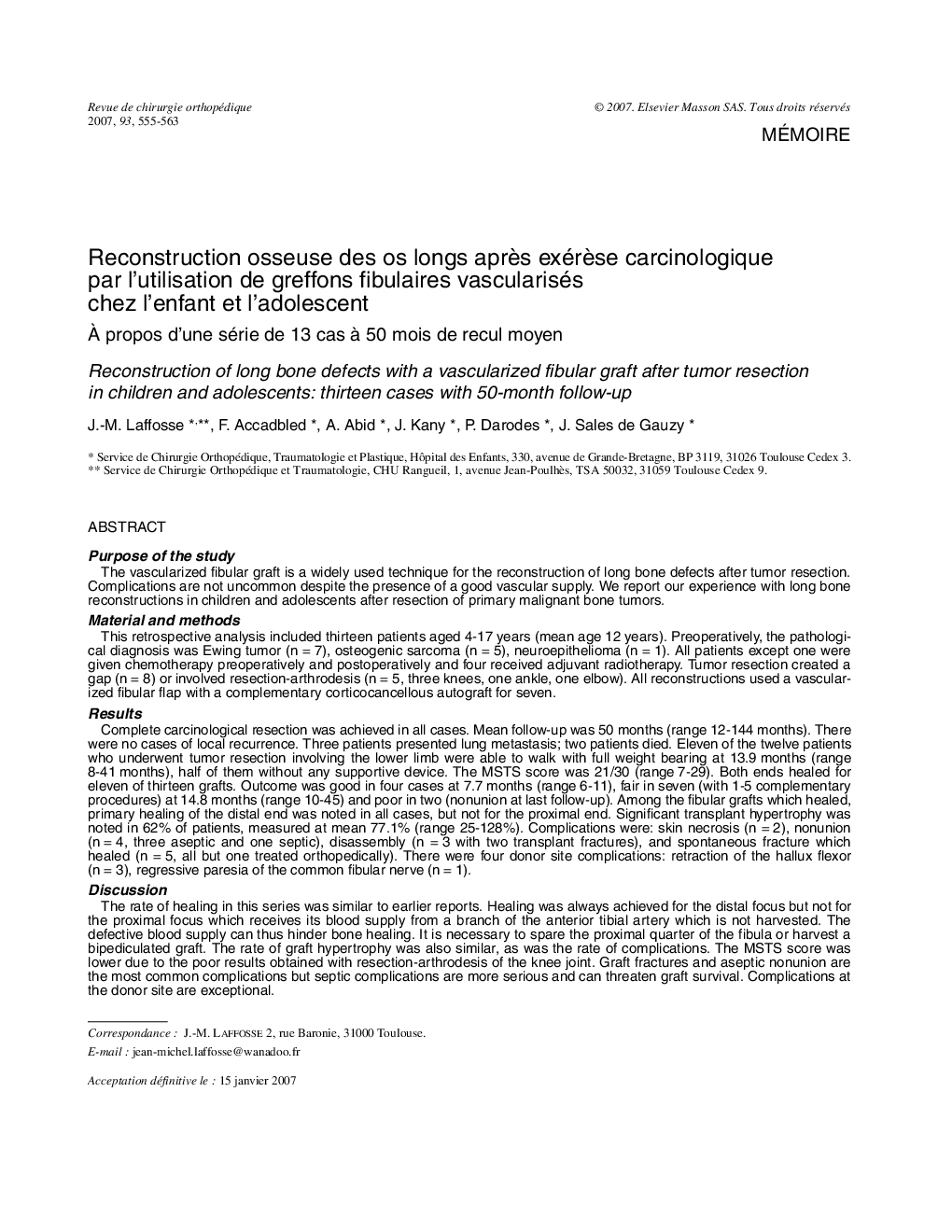| کد مقاله | کد نشریه | سال انتشار | مقاله انگلیسی | نسخه تمام متن |
|---|---|---|---|---|
| 4088573 | 1268109 | 2007 | 9 صفحه PDF | دانلود رایگان |

RésuméLa technique des greffons fibulaires vascularisés fait partie de l’arsenal thérapeutique des reconstructions des pertes de substance osseuse après exérèse tumorale. Nous rapportons notre expérience concernant cette technique chez l’enfant après résection carcinologique de tumeurs osseuses primitives malignes.Il s’agit d’une série rétrospective de 13 patients d’âge moyen 12 ans (4-17) comportant : 7 tumeurs d’Ewing, 5 ostéosarcomes, un neuroépithéliome. Tous les patients (sauf un) ont bénéficié d’une chimiothérapie pré et postopératoire et 4 d’une radiothérapie adjuvante. Nous avons réalisé une reconstruction par fibula vascularisée à pédicule fibulaire, associée 7 fois à une autogreffe cortico-spongieuse, après 8 résections intercalaires et 5 résection-arthrodèses.L’exérèse carcinologique a toujours été complète. Au recul de 50 mois (12-144), il n’y avait aucune récidive locale. Trois patients ont présenté des métastases pulmonaires ; deux étaient décédés. Onze patients sur les douze opérés au membre inférieur marchaient en plein appui à 13,9 mois (8-41) dont la moitié sans aucun appareillage. Le score MSTS était de 21/30 (7-29). Onze transplants sur treize étaient solides aux deux extrémités : 4 bons résultats à 7,7 mois (6-11), 7 moyens (une à 5 interventions supplémentaires) à 14,8 mois (10-45) et 2 mauvais (non consolidés). Tous les foyers fibulaires distaux ont consolidé en première intention, à la différence des foyers proximaux. L’hypertrophie du transplant était significative dans 62 % des cas, en moyenne 77,1 % (25-158). Les complications dénombrées ont été : 2 nécroses cutanées, 4 pseudarthroses (3 aseptiques et une septique), 3 démontages (2 fractures du transplant) et 5 fractures spontanées, toutes traitées orthopédiquement (sauf une) et ayant consolidé. Quatre complications ont été observées au site donneur : 3 rétractions du fléchisseur de l’hallux, une parésie régressive du nerf fibulaire commun.
Purpose of the studyThe vascularized fibular graft is a widely used technique for the reconstruction of long bone defects after tumor resection. Complications are not uncommon despite the presence of a good vascular supply. We report our experience with long bone reconstructions in children and adolescents after resection of primary malignant bone tumors.Material and methodsThis retrospective analysis included thirteen patients aged 4-17 years (mean age 12 years). Preoperatively, the pathological diagnosis was Ewing tumor (n = 7), osteogenic sarcoma (n = 5), neuroepithelioma (n = 1). All patients except one were given chemotherapy preoperatively and postoperatively and four received adjuvant radiotherapy. Tumor resection created a gap (n = 8) or involved resection-arthrodesis (n = 5, three knees, one ankle, one elbow). All reconstructions used a vascularized fibular flap with a complementary corticocancellous autograft for seven.ResultsComplete carcinological resection was achieved in all cases. Mean follow-up was 50 months (range 12-144 months). There were no cases of local recurrence. Three patients presented lung metastasis; two patients died. Eleven of the twelve patients who underwent tumor resection involving the lower limb were able to walk with full weight bearing at 13.9 months (range 841 months), half of them without any supportive device. The MSTS score was 21/30 (range 7-29). Both ends healed for eleven of thirteen grafts. Outcome was good in four cases at 7.7 months (range 6-11), fair in seven (with 1-5 complementary procedures) at 14.8 months (range 10-45) and poor in two (nonunion at last follow-up). Among the fibular grafts which healed, primary healing of the distal end was noted in all cases, but not for the proximal end. Significant transplant hypertrophy was noted in 62% of patients, measured at mean 77.1% (range 25-128%). Complications were: skin necrosis (n = 2), nonunion (n = 4, three aseptic and one septic), disassembly (n = 3 with two transplant fractures), and spontaneous fracture which healed (n = 5, all but one treated orthopedically). There were four donor site complications: retraction of the hallux flexor (n = 3), regressive paresia of the common fibular nerve (n = 1).DiscussionThe rate of healing in this series was similar to earlier reports. Healing was always achieved for the distal focus but not for the proximal focus which receives its blood supply from a branch of the anterior tibial artery which is not harvested. The defective blood supply can thus hinder bone healing. It is necessary to spare the proximal quarter of the fibula or harvest a bipediculated graft. The rate of graft hypertrophy was also similar, as was the rate of complications. The MSTS score was lower due to the poor results obtained with resection-arthrodesis of the knee joint. Graft fractures and aseptic nonunion are the most common complications but septic complications are more serious and can threaten graft survival. Complications at the donor site are exceptional.ConclusionLong bone reconstruction using an autologous vascularized fibular graft is a reliable technique providing satisfactory functional results. Complications can be prevented by making solid fixation and using a corticocancellous graft creating a favorable osteoinducing environment. A massive allograft is another solution providing good immediate mechanical stability.
Journal: Revue de Chirurgie Orthopédique et Réparatrice de l'Appareil Moteur - Volume 93, Issue 6, October 2007, Pages 555-563